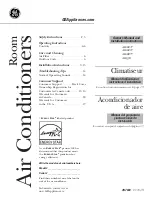
– 53 –
A shaft with a rubber plug on the end is connected
to the bellows. When the outdoor temperature
remains above a certain temperature, the bellows
expand and the plug fi ts tightly in a hole in the
bottom, or base pan, of the unit. When the plug is
blocking the hole, as it should be during cooling
operation, the condensate water is contained in the
base pan. At temperatures when heating is required,
the bellows contract, the rubber plug is retracted
from the hole, and the heat pump condensate water
is allowed to drain into the wall case. The valve is
fully open at 49°F.
Drain Kits
Although the Zoneline units are designed to
dissipate most of the condensate generated
during normal cooling operation, there may be
times when abnormal operating conditions cause
more condensate than the unit can dissipate.
Heat pumps also generate condensate that the
unit may not be designed to dissipate. For these
reasons, if condensate dripping from the wall case is
objectionable, an internal or external drain system
should be installed.
Internal Condensate Removal (ICR) System
Note:
Units with ICR may not be installed in
seacoast or corrosive environment applications.
GE has developed an internal condensate removal
(ICR) system for packaged terminal heat pumps. This
system has been offered as an option on Zoneline
packaged terminal heat pumps since 1982, and
thousands of them are in use. During heat pump
operation, the ICR system utilizes a small pump to
lift the water from the base pan and pump it into
a collector tray positioned above the indoor coil.
The water drains from the collector tray and drips
onto the warm indoor coil where it is evaporated
into the room atmosphere. If an excess amount
of water is pumped to the indoor side, it is routed
back to the outdoor portion of the base pan. The
ICR system has proven to be an effective means of
minimizing the amount of heat pump condensate
dripping from the unit. However, if the restrictions
of a particular installation will allow absolutely no
dripping of condensate water from the wall case,
the installation of an external drain system is
recommended.
Condensate Disposal Systems
Slinger Ring Systems
Packaged Terminal units employ various means
of dispersing the condensate water against the
outdoor coil. One of the most popular and most
effective means is the use of a “slinger ring”. A
“slinger ring” is a ring around the circumference of
the outdoor fan. The design of the unit positions the
slinger ring very close to the bottom of the base
pan so water in the base pan is lifted by the rotating
ring. Water picked up by the slinger ring will be
dispersed into the air stream and deposited on the
hot outdoor coil where it evaporates.
All Zoneline series packaged terminal air
conditioners and packaged terminal heat pumps
utilize a slinger ring for cooling condensate disposal.
Heat Pump Condensate
During the operation of a unit in the heat-pump
mode, the outdoor coil becomes the cold coil
and the indoor coil becomes the hot coil due to
reversing the fl ow of the refrigerant. When the
temperature of the outdoor coil is below the dew
point, condensation will form on the outdoor coil
just as it does on the indoor coil during cooling
operation. Since the dew point is humidity-related
and temperature-related, there may be more
condensate on days when the relative humidity is
high.
Heat Pump Condensate Disposal
Since the outdoor coil is cold during heat pump
operation, the condensate water cannot be
deposited on the outdoor coil as the water would
cause frost to form on the coil. This frost would block
the airfl ow through the coil. Rather than allow this
problem to occur, heat pump units must dispose of
the condensate in another manner.
Temperature Activated Drain Valve
The most widely used
method of disposing of heat
pump condensate is with
a temperature activated
drain valve. This is a device
mounted in the base pan of a
heat pump unit with a bellows
that expands on temperature
rise and contracts with
temperature drop.
All manuals and user guides at all-guides.com








































